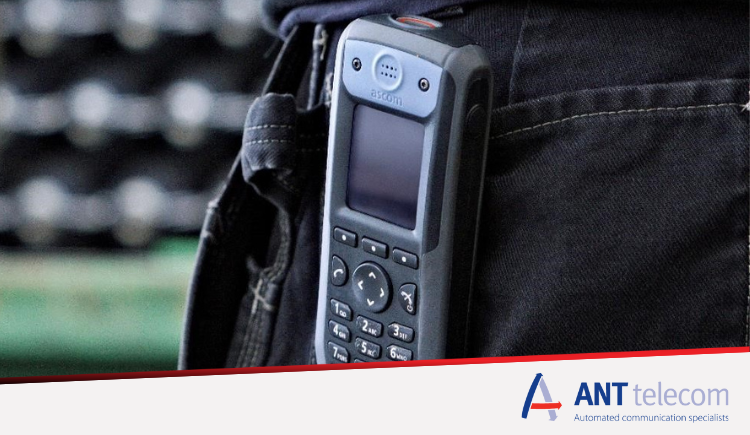
DECT stands for Digital Enhanced Cordless Telephones and commonly found in peoples’ homes as well as in businesses. An IP DECT system, as opposed to domestic DECT, can be used by multiple people (hundreds if necessary) operating across a whole premises or site.
In this blog we discuss 5 ways that an IP DECT system can improve your business.
1) Improve Communication throughout the business
IP DECT systems help mobile teams collaborate more easily making them and their businesses more efficient and productive too. DECT phones are used by all types of professional people including office based staff e.g., IT teams that need to roam the site to support their colleagues - to workers that operate in sectors like hospitals, manufacturing and retail where teams are predominantly more mobile than desk based.
Giving mobile teams the freedom to make and receive calls anywhere on site usually results in an increase in efficiency and productivity. Staff can respond more quickly and resolve problems on the spot 1st time round, without the need to make call backs or find the nearest telephone after receiving a paging message or hearing a tannoy announcement.
DECT phones can replace desk top phones for those people that don’t really need one or work alongside them. Features like “double call” or “twinning” make the DECT phone ring at the same time as desk top. This makes it easy to reach the intended person as the caller only has one number to try.
2) Improve Staff Protection and Lone Worker Safety
Working alone is quite common and can help businesses operate effectively especially when tasks don’t require two people – as twice as much can get done. Of course, where lone working does take place it is important that any activity is done safely and you must implement procedures and train staff properly to ensure this is the case.
When incidents or accidents happen in the workplace, colleagues are likely to see or hear something and immediately offer assistance, especially if it seems serious. However, that’s unlikely to be the case for lone workers as incidents would go unnoticed and therefore puts them at greater risk.
The Health and Safety Executive (HSE) recommends that companies should implement procedures to ensure lone workers are supervised regularly throughout the day. However, usually these methods become quite onerous and after a while the “checking in” becomes less frequent until it finally stops – leaving both the lone workers and business at risk.
The HSE also recommends using technology where it is appropriate. DECT handsets are a good way to protect lone workers as they provide them with a way to call a colleague if they need help. In many cases, this alone might be enough and it is certainly better than nothing. However, there is still a good chance responders, who don’t realise it is an emergency, don’t answer the call. And in some instances it may not even be possible to make a telephone call.

This is where SOS buttons integrated on the side of DECT handsets really help. These alerts are presented to a responder group as an emergency message, on their DECT phones, all at the same time ensuring a reaction. The name of the person that triggered the alert, their location and number appear in the message making it really easy to contact or locate and support their colleague. Once the alarm is acknowledged and the response team updated, further escalation messages seize.
Click here to learn more about mobile communication technology
DECT handsets can also come with tilt sensors that can raise alarms automatically, if the user is rendered unconscious and the handset tilts beyond a certain angle.
Therefore, providing customers install the right DECT system in the first place (not all DECT systems have lone worker features) it is possible to implement a very robust lone worker procedure using DECT technology. Furthermore, it’s not a costly uplift – it just requires additional DECT lone worker handsets and a messaging platform, if not in situ, to send the alerts.
3 Improve Security and Site Access
IP DECT can integrate with access control systems to help maintain security levels and improve site access.
Many industrial companies restrict access to their premises by installing security gates. However, manning these gates is expensive especially when footfall to the site is low. Access control system are a cost effective alternative as these systems have control mechanisms that open doors and gates automatically with a code or card. However, effective as they are for employees, they can be a nuisance for visitors like delivery drivers that don’t have the code. Instead, visitors press a button on a gate panel to speak with an employee inside the premises to open the gate. However, if no one answers, which can often be the case as the access phone is usually installed near an entrance door where it is not easily accessible, the delivery driver has to wait until they give up and go onto the next job.
By integrating the DECT with a door entry system means calls are presented to the DECT handsets that workers carry with them at all times. Staff can speak directly to the visitor and open the gate, all from their DECT phone without moving from their spot.
4) Improve response and fix times to alarms, machine and equipment failures
Many industrial companies have automated facilities using machinery to manufacture their products. These processes are very smooth and often require very little manual input. However, when equipment and machinery fail, companies don’t have the same seamless procedures in place to notify the maintenance or engineering team and cause unnecessary delays, bottlenecks, additional waste and higher production costs as a result.
Manufacturing companies use systems e.g. SCADA and PLC to monitor specific conditions of all their machinery and equipment. When parameters have been met, these systems will signal a fault by displaying a red light by the machine itself or on the display monitor. However, to notice the alarm, operators have to be monitoring the screen itself or be by the machine, which isn’t always the case.
When alarms are seen, operators then have to call members of the maintenance team to find someone that can manage the incident.
Alternatively, integrating the DECT system with a monitoring platform provides a far more robust and cost effective, automated method of managing machine alarms. By presenting alarms directly on the response teams’ DECT phones provides an immediate notification. Each member of the team is alerted simultaneously and by acknowledging it, updates the rest of team and prevents further escalation. Alert messages detail which machine has an issue, the type of fault and its location.
When operators do eventually see the alarm information on their screen, they’ll see that it has been acknowledged and by whom, and know who to follow up with for further updates if required.
5) Improve Task Management with PTT
PTT stands for Push to Talk and is a brilliant feature but is not available on all IP DECT systems. PTT provides an effective way for users to communicate with their team (or another) and in particular share information and distribute tasks.
For example, in supermarkets it’s important to clean up spillages immediately or at least warn people with a sign to prevent anyone from slipping over and injuring themselves. In hotels, the concierge may need colleagues to come quickly to assist guests with their luggage. In both scenarios it’s helpful to communicate directly with the team responsible and hear an instant response.
With PTT users don’t need to ring a number or wait for a call to be answered, they simply push a button on their handset and talk. Their announcement is broadcasted to their group who all hear it on their handset and can respond in a similar manner.
Different groups can be set up and members can be part of just one or multiple groups.
If you would like to know more information or a demonstration of an IP DECT system, please get in touch with us. You can find all our contact details by clicking on the contact us tab at the top right of this page.



